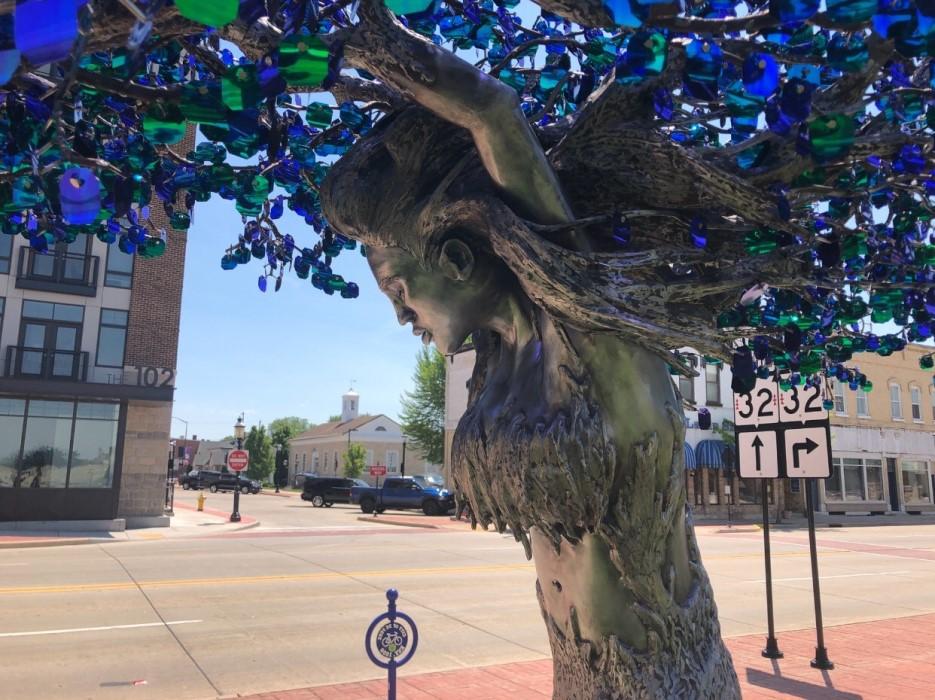- FMA
- The Fabricator
- FABTECH
- Canadian Metalworking
Categories
- Additive Manufacturing
- Aluminum Welding
- Arc Welding
- Assembly and Joining
- Automation and Robotics
- Bending and Forming
- Consumables
- Cutting and Weld Prep
- Electric Vehicles
- En Español
- Finishing
- Hydroforming
- Laser Cutting
- Laser Welding
- Machining
- Manufacturing Software
- Materials Handling
- Metals/Materials
- Oxyfuel Cutting
- Plasma Cutting
- Power Tools
- Punching and Other Holemaking
- Roll Forming
- Safety
- Sawing
- Shearing
- Shop Management
- Testing and Measuring
- Tube and Pipe Fabrication
- Tube and Pipe Production
- Waterjet Cutting
Industry Directory
Webcasts
Podcasts
FAB 40
Advertise
Subscribe
Account Login
Search
Fabricator excels in artistic, structurally sound sculptures
Artist relies on decades of fab experience to develop breathtaking works in metal
- By Eric Lundin
- April 17, 2021
- Article
- Arc Welding

Despite having no art background, metal fabricator David Windey has a knack for building flora and fauna with lifelike contours and realistic textures. Images: David Windey
Fine artwork takes time. Raphael spent more than a year painting “La Fornarina.” Leonardo da Vinci supposedly spent three years on “Last Supper” and four years on “Mona Lisa.” Michelangelo worked on his most famous sculpture, “David,” from 1501 to 1504.
It’s a stretch to compare a modern metal fabricator with the masters of the Renaissance, but in the matter of perseverance, David Windey has something in common with them. The former fabricator who makes his living as an artist puts in a lot of time to build sculptures.
“It’s a lot of hammer-and-anvil time,” he said.
He spent most of his career working at a custom metal fabrication shop, Ritchie Metal Works (De Pere, Wis., near Green Bay). Decades in the shop provided an excellent foundation for Windey’s current work.
“A spiral staircase is a good example,” he said. Quite a bit of hard work goes into making such a project successfully and the outcome has to be aesthetically pleasing, dimensionally accurate, and robust. It’s exacting, precise work.
“All of the little measurements are critical,” he added.
Although precise measurements aren’t always necessary in artwork, Windey relies on the fabricating knowledge, patience, and engineering principles he learned when working for Ritchie. One of his sculptures, an elephant that appears to be balanced on a ball, is a good example. Certainly, making an entire elephant is a daunting task, but Windey makes it sound easy, starting by making a leg, then another leg, then a foot, and so on. However, it’s clear that it takes a vast amount of focus and perseverance.
Of course, other artists could do it too, and the first week might not be bad, but it’s a relentless drive to finish the project that carries Windey through the remaining 19 or so weeks.
The other ace up his sleeve is his ability to build technically challenging pieces.
“I had to cantilever a lot of weight,” he said. “Anyone can make an elephant, but can anyone make a strong elephant? I didn’t want to warn people to keep children off of it because children like to play on things like this, so it’s strong enough. They can climb on it, sit on the trunk, and it’s not going to budge. I think you could lift it by the tail.”

Windey has a standard price for trees starting at 3 feet high but he isn’t tied to any specific type or style. This one, “The Transformation of Daphne,” captures a moment from Greek mythology as the nymph Daphne escapes from Apollo to become a laurel tree.
While the elephant is a showcase piece, he’s known for making trees that dazzle. Windey advertises a basic 3-ft. tree, but the sky is the limit. While the tree trunks and branches are lifelike and natural-looking, it’s the leaves that make them magical. On most trees, the leaves number in the thousands. Thousands upon thousands.
“The leaves are available in any color or combination of colors and coated for UV protection,” he said. The big deal is that the color application method is a holographic process, which gives the leaves a 3D appearance. The leaves aren’t fixed to the branches; they hang and flutter in the wind, creating a breathtaking sight.
About the Author

Eric Lundin
2135 Point Blvd
Elgin, IL 60123
815-227-8262
Eric Lundin worked on The Tube & Pipe Journal from 2000 to 2022.
subscribe now

The Fabricator is North America's leading magazine for the metal forming and fabricating industry. The magazine delivers the news, technical articles, and case histories that enable fabricators to do their jobs more efficiently. The Fabricator has served the industry since 1970.
start your free subscription- Stay connected from anywhere

Easily access valuable industry resources now with full access to the digital edition of The Fabricator.

Easily access valuable industry resources now with full access to the digital edition of The Welder.

Easily access valuable industry resources now with full access to the digital edition of The Tube and Pipe Journal.
- Podcasting
- Podcast:
- The Fabricator Podcast
- Published:
- 04/16/2024
- Running Time:
- 63:29
In this episode of The Fabricator Podcast, Caleb Chamberlain, co-founder and CEO of OSH Cut, discusses his company’s...
- Industry Events
16th Annual Safety Conference
- April 30 - May 1, 2024
- Elgin,
Pipe and Tube Conference
- May 21 - 22, 2024
- Omaha, NE
World-Class Roll Forming Workshop
- June 5 - 6, 2024
- Louisville, KY
Advanced Laser Application Workshop
- June 25 - 27, 2024
- Novi, MI
































